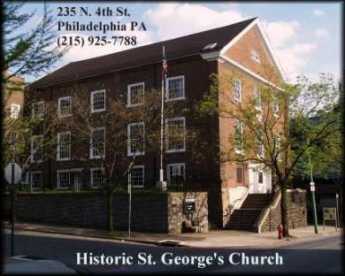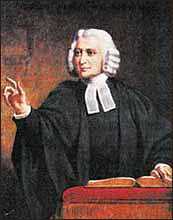Related Topics
Religious Philadelphia
William Penn wanted a colony with religious freedom. A considerable number, if not the majority, of American religious denominations were founded in this city. The main misconception about religious Philadelphia is that it is Quaker-dominated. But the broader misconception is that it is not Quaker-dominated.
Tourist Walk in Olde Philadelphia
Colonial Philadelphia can be seen in a hard day's walk, if you stick to the center of town.
Arch Street: from Sixth to Second
When the large meeting house at Fourth and Arch was built, many Quakers moved their houses to the area. At that time, "North of Market" implied the Quaker region of town.
The Revolutionary Origins of The Methodist Church

|
| Methodist Church |
There were no signers of the Declaration of Independence who were official Methodists, for the simple reason the Methodist Church was not created until 1784 when John Wesley, secretly ordained its first ministers. However, there is room to believe the movements eventually creating the Methodist Church played a central role in American agitation for independence.
The origins are a little confusing. John and Charles Wesley were both priests in the Church of England, and John famously declared, "I will live and die an Anglican." While at Oxford, they founded a bible and ethical study society which came to be called the Holy Club, and because of systematic thoroughness were familiarly known as Methodists. A systematic study of the Bible in small class groups was a central feature. There was no dissatisfaction with, or rebellion from, the Church of England. Missionary zeal was a second early feature of the group, and some early missionaries like Bishop Francis Asbury were especially active in the American colonies. When Asbury came to America there were 1200 adherents of the general concepts, and when he died there were a quarter of a million formal members of the church. This rapid growth soon became its main problem, because the Anglican Church simply could not supply enough priests, and so the local congregations demanded the right to ordain their own ministers. Wesley agreed but did it secretly. America was a long way from England, and the idea of a local church, independent of England, soon made its appearance, particularly as local practices began to diverge from the Anglican ones.
Missionary zeal soon evolved into a more exhortational evangelism. In Pennsylvania Quaker country, restlessness with Quaker silence produced a reaction of joyous outcry during religious meetings, creating the description "shouting Methodists". Hymn singing was important as a result of Charles Wesley's influence and many Methodist hymns have been adopted by other Protestant denominations. Drunkenness was a major problem in the colonies, and anti-drunkenness or temperance, was the main feature of Methodist attention. A century later, Methodist ministers were to found the Salvation Army, which embodies many of the principles of evangelical, hymn singing anti-drunkenness crusading.

|
| Charles Wesley |
From its earliest days, Methodism welcomed blacks into membership, although a segregationist strain to it ultimately caused trouble. A central figure in the configuration of the early Methodist Church was John Newton, the captain of a slave ship. After nearly perishing in a storm, Newton attributed his rescue to God's intervention, writing the famous hymn, Amazing Grace. He spent the rest of his life in evangelical activities, with particular emphasis on black people.
Although his American visit preceded the formation of the Church, George Whitefield the evangelical preacher played a major role in preparing the Colonial Philadelphia populace for the concepts of Methodism. He attracted great crowds to his sermons, and Benjamin Franklin describes in his autobiography the great impact Whitefield had on him. Now, as it happened, the German Reform church had started but was unable to complete a church building at 235 North 4th Street, which was sold at auction to members of the local Methodist Society. This church building, started in 1763, purchased in 1767, and completed in 1769, can fairly claim to be the oldest Methodist Church building in continuous service in the world, although the dates of these things are pretty confusing for a church officially created in 1784. Just to make things more difficult to understand, Barratt's Chapel, ten miles south of Dover, Delaware, was completed in 1784 on land donated in 1780. If you say it slowly, you can see that it is possible to describe Barratt's Chapel as the oldest house of worship built by and for Methodists. John Wesley's chapel, on City Road, London, is however still the mother church, so to speak. St. George's Church in Philadelphia is notable for ordaining the first black minister, Richard Allen, who had been born a slave of Benjamin Chew (the Chief Justice, whose house was Cliveden, the scene of the Battle of Germantown). Allen was obviously a remarkable person, who bought his own freedom by working as a shoemaker, and who later drove wagons from Rehoboth, Delaware to Valley Forge during the Revolution. (Allen had actually been sold by Chew to Stockley Sturgis, a Delaware plantation owner, who is the one who remorsefully sold him his freedom). Allen often preached five times a day, built up a huge following in the black community, and broke off to form the African Methodist Episcopal Church. The first Church was Bethel, replaced several times at 6th Lombard Streets, but there are now many others across the country.
Visitors from New Jersey, crossing the Benjamin Franklin Bridge, will be able to see the top half of St. George's Church as they descend into Philadelphia. At Christmastime, the windows are lit with real candles, and the interior is a beautifully simple white room. It now has less than a hundred members, but houses the genealogy and other church records for a wide area, and is very popular with people doing research. The bishop's chair dates from Bishop Asbury. Barratt's Chapel is smaller and simpler, but the highway makes a wide swing around it and its burial ground, so it remains a prominent feature of the area around Frederica. It takes several minutes to drive around it, even at high speed, on the way to the Delaware beaches. Wesley College is not far away. Stockley (currently pronounced Stoakly) is commemorated as the name of a small town on the highway, twenty miles south of here.
Originally published: Thursday, August 11, 1994; most-recently modified: Wednesday, May 22, 2019